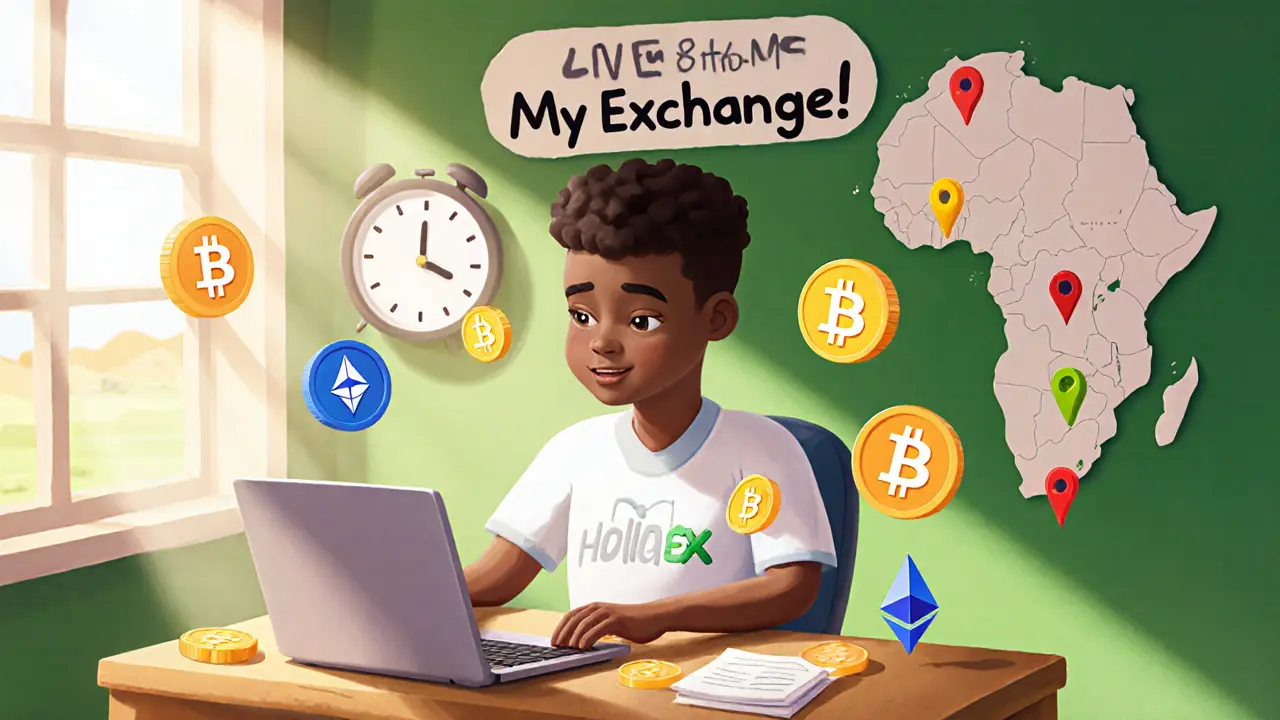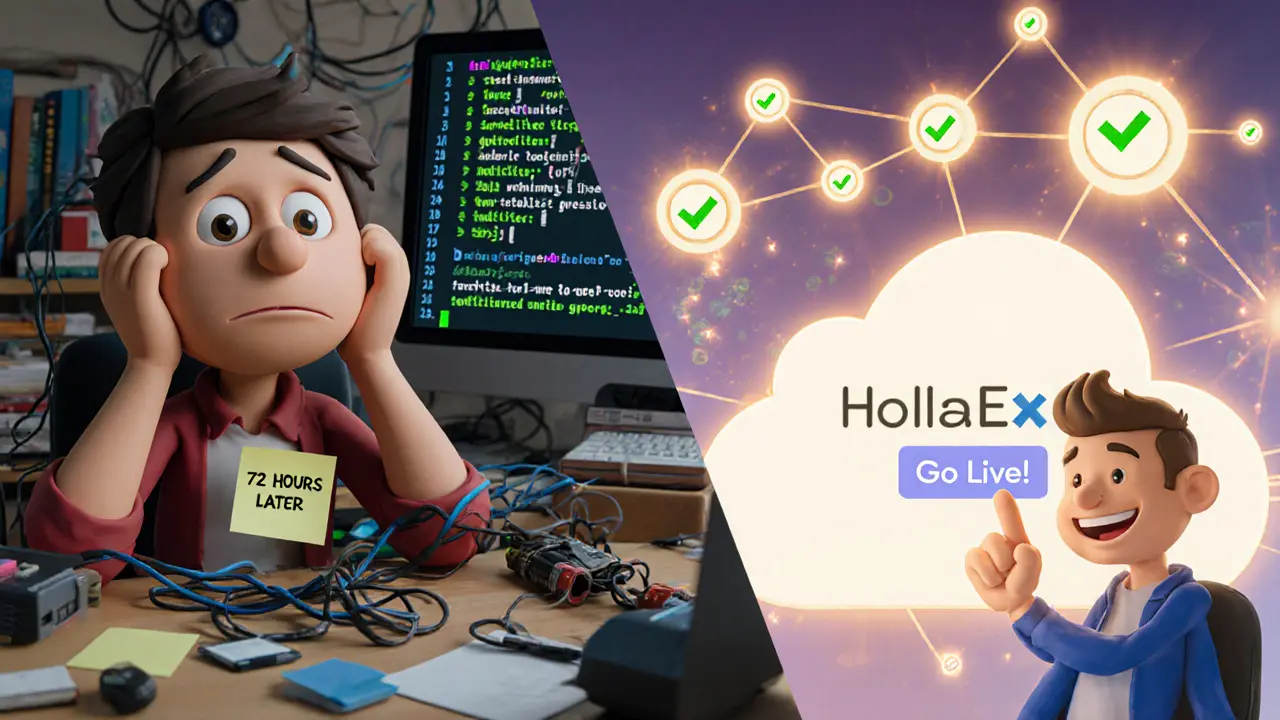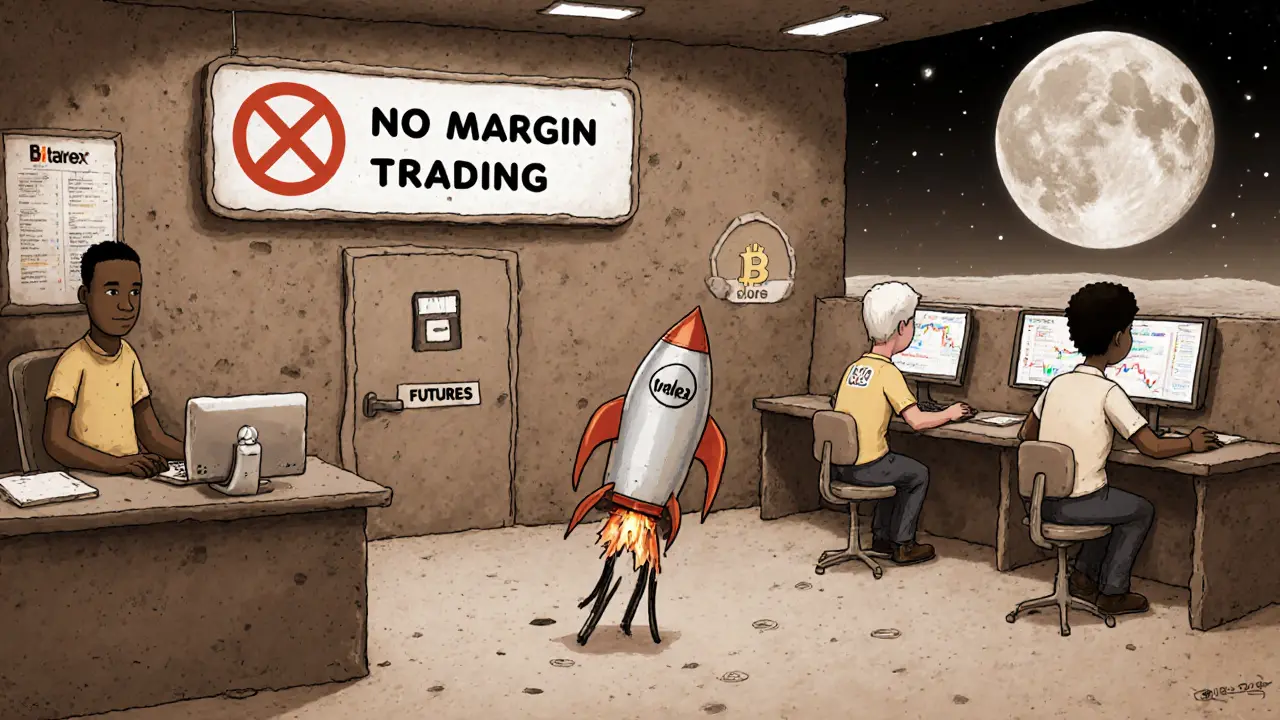HollaEx Crypto Exchange Review: Best for Startups, Not Advanced Traders
 Dec, 8 2024
Dec, 8 2024
HollaEx Exchange Suitability Calculator
Find Your Perfect Exchange Match
Answer a few questions to see if HollaEx is right for your business. This tool will analyze your needs against HollaEx's capabilities.
Want to launch your own crypto exchange but don’t have millions to spend? HollaEx might be the answer - if you know what you’re getting into. Unlike big names like Binance or Coinbase, HollaEx doesn’t run an exchange for you. Instead, it gives you the tools to build your own - fast, cheap, and with real control. But here’s the catch: it’s not for everyone. If you’re a solo entrepreneur in Nigeria, Indonesia, or Colombia looking to serve your local market, HollaEx could be a game-changer. If you’re planning to compete with Kraken or FTX on margin trading and high-frequency volume? You’ll hit walls fast.
What Exactly Is HollaEx?
HollaEx is a white-label crypto exchange platform built for people who want to launch their own exchange without hiring a team of engineers. It’s not a hosted service like Binance Cloud - it’s two things in one. First, there’s the HollaEx Kit, a fully open-source exchange codebase built with JavaScript and Node.js. You can download it, host it on your own server, and tweak every line of code. Second, there’s the cloud-hosted version, where HollaEx handles the infrastructure and you just log in, customize the look, and start trading.
Since 2019, HollaEx has powered over 100 exchanges across 21 countries. Most of these are small, regional platforms targeting local users - think Bitcoin trading in Kenya or altcoin markets in the Philippines. The platform supports 50 trading pairs, including Bitcoin, Ethereum, and dozens of smaller tokens. It’s not the most extensive list in the world, but it’s enough to get started.
How Fast Can You Launch?
This is where HollaEx shines. On the cloud plan, you can go from zero to live exchange in under 8 hours. That’s not a guess - it’s what users on GetApp and AWS Marketplace reported. You pick your logo, change the color scheme, add your preferred coins, and flip a switch. No server setup. No SSL certificates. No blockchain node syncing.
The self-hosted version? That’s a different story. If you’re using the open-source Kit, expect to spend 3 to 5 days setting it up - assuming you know how to work with Node.js, configure Bitcoin Core or Ethereum clients, and manage Linux servers. One Reddit user, CryptoNewbie2024, spent 72 hours trying to get it running before hiring a developer. That’s not a flaw in HollaEx - it’s a reality check. The open-source version isn’t plug-and-play. It’s a toolkit for builders.
Security: Solid, But Not Enterprise-Grade
HollaEx doesn’t cut corners on security. It includes multi-factor authentication via Google Authenticator, email confirmation for withdrawals, and encrypted data storage. Cold wallet integration is supported, so you can keep most funds offline. Techreviewer’s 2024 security audit confirmed these features are properly implemented.
But here’s what’s missing: institutional-grade protections. No insurance fund. No cold wallet insurance. No DDoS protection beyond basic cloud provider tools. If you’re running a small exchange for 500 users, this is fine. If you’re aiming for 50,000 users and $10 million in daily volume? You’ll need more.
Liquidity: The Secret Weapon
Most new exchanges die because nobody trades. HollaEx solves that with its shared liquidity network. When you join, your exchange connects to a pool of other HollaEx-powered platforms. That means even if you’re the only one in your country trading BTC/USDT, you’re still getting orders from users in Brazil, India, and South Africa.
One operator on GetApp said their trading volume jumped 85% in the first month just because of this feature. That’s huge. No other white-label solution offers this out of the box. You don’t need to pay for liquidity providers or negotiate with market makers. It’s built in.

What You Can’t Do
Here’s the hard truth: HollaEx doesn’t support futures, margin trading, or leverage. Not now, not in the base version. That’s a major gap. In 2025, over 70% of crypto exchanges offer some form of leveraged trading. If your users want to go long on SOL with 10x leverage, HollaEx can’t help. G2 reviewers called this out repeatedly as a dealbreaker.
Also missing: advanced order types like stop-limit, trailing stops, or OCO orders. The trading interface is clean and simple - great for beginners, terrible for pros. If your target audience is retail traders who want to buy Bitcoin and hold, you’re golden. If you’re trying to attract day traders? Look elsewhere.
Pricing: Cheaper Than Almost Everything Else
HollaEx’s cloud plan starts at $700 per month. That’s it. No setup fee. No revenue share. No hidden charges. Compare that to AlphaPoint ($5,000/month), CoinImpress ($2,500/month), or even Binance Cloud (which doesn’t publicly list prices but is known to cost $10k+).
For startups and small teams, this is a massive advantage. You’re paying for a turnkey solution that includes hosting, security, liquidity, and updates. The open-source Kit? Free. But you pay in time and technical skill. Most users end up hiring a developer anyway, so the real cost of the free version often ends up being $5,000-$10,000 in labor.
Customization: Deep, But Only for Developers
HollaEx gives you full access to the source code. Want to add a new coin? You can. Want to change how the order book displays? You can. Want to integrate a custom KYC provider? You can - if you know JavaScript and React.
But here’s the problem: the documentation assumes you’re a developer. If you’re not, you’re stuck. One AWS Marketplace reviewer said, “To make any additional changes requires a pretty skilled developer.” That’s the bottleneck. HollaEx lets you customize everything - but only if you can code.

Who Should Use HollaEx?
Let’s cut through the noise. HollaEx isn’t for everyone. Here’s who it’s perfect for:
- Entrepreneurs in emerging markets (Africa, Southeast Asia, Latin America) wanting to launch a local exchange.
- Small teams with one developer or access to freelance dev help.
- Businesses that need to launch fast and stay under $1,000/month.
- Projects targeting simple spot trading - no leverage, no derivatives.
Here’s who should avoid it:
- Anyone needing margin or futures trading.
- Companies targeting institutional clients or high-volume traders.
- Teams with zero technical resources and no budget for developers.
- Exchanges planning to scale beyond 10,000 active users.
What’s Next for HollaEx?
The company’s roadmap is clear. They’re working on adding margin and futures trading by Q2 2025. Mobile apps are in development. They’re also expanding regulatory templates for 15 more countries - a big deal for compliance-heavy regions like Europe and Canada.
But here’s the risk: competitors are catching up. New platforms are launching with similar open-source + cloud models, better UIs, and built-in futures. HollaEx’s edge is cost and speed - not innovation. If they don’t deliver on futures by mid-2025, they’ll start losing ground.
Final Verdict
HollaEx is the most affordable, fastest way to launch a crypto exchange today. It’s not flashy. It’s not for advanced traders. But for small operators in emerging markets? It’s one of the few tools that actually works.
If you’ve got a developer on your team or can afford one, and you want to serve a local market with spot trading - go for it. Launch in a week. Start earning fees. Test the waters.
If you’re hoping to build the next Binance? Keep looking. HollaEx is a launchpad, not a rocket ship.
Does HollaEx support margin and futures trading?
No, HollaEx does not currently support margin trading or futures contracts. This is a major limitation for traders looking to use leverage or trade derivatives. However, the company has confirmed these features are planned for release in Q2 2025 according to their public roadmap.
How long does it take to set up a HollaEx exchange?
On the cloud-hosted plan, setup takes 2 to 8 hours. You just log in, add your coins, customize the branding, and go live. For the self-hosted open-source Kit, expect 3 to 5 days if you’re technically experienced. Beginners often need a week or more and may need to hire a developer.
Is HollaEx free to use?
The HollaEx Kit is open-source and free to download. But hosting it yourself requires servers, blockchain nodes, and developer time - which usually costs thousands of dollars. The cloud-hosted version starts at $700/month, which includes everything: hosting, security, liquidity, and updates.
Can I use HollaEx without coding skills?
Yes - but only if you use the cloud-hosted version. You can fully operate the exchange without writing code. However, if you want to make any changes beyond colors and logos - like adding new features or integrating custom tools - you’ll need a developer. The open-source version requires coding skills to use.
How does HollaEx handle liquidity?
HollaEx connects all its exchanges to a shared liquidity pool. This means your users can trade against orders from other HollaEx-powered exchanges around the world. This feature boosts trading volume significantly - users report up to 85% higher volume in the first month compared to standalone exchanges.
Is HollaEx secure enough for a real exchange?
Yes, for small to medium exchanges. HollaEx includes multi-factor authentication, email confirmation for withdrawals, cold wallet support, and encryption. However, it lacks enterprise features like insurance funds, advanced DDoS protection, or institutional-grade audits. It’s secure enough for local markets but not for large-scale operations.
What countries use HollaEx the most?
65% of HollaEx’s 100+ operational exchanges are in Southeast Asia, Africa, and Latin America. These regions benefit most from its low cost and fast deployment. It’s less common in North America and Europe, where regulatory hurdles and competition from larger exchanges are higher.
How does HollaEx compare to Binance Cloud?
Binance Cloud is more scalable and offers futures, margin, and institutional tools - but it’s far more expensive and less customizable. HollaEx is cheaper, open-source, and gives you full control, but lacks advanced trading features. Binance Cloud is for businesses ready to scale. HollaEx is for startups and regional players.
Next Steps If You’re Considering HollaEx
Start with the cloud demo. HollaEx offers a free trial - no credit card needed. Try creating a mock exchange. See how easy it is to add coins, change the logo, and test a trade. If it feels intuitive, you’re on the right track.
If you’re thinking of the open-source version, hire a developer first. Don’t waste weeks trying to figure it out alone. Look for someone with experience in Node.js, blockchain wallets, and exchange APIs.
And always check local regulations. HollaEx gives you the tools - but you’re responsible for KYC/AML compliance in your country. That’s where most new exchanges fail.
Puspendu Roy Karmakar
November 26, 2025 AT 04:41HollaEx is a godsend for guys like me in India trying to launch something local without going broke. I set up my exchange in under 6 hours using the cloud plan - just swapped the logo, added INR pairs, and boom, people started trading. No devs needed. The shared liquidity is wild - I got trades from Nigeria and Brazil within hours. Not for pros, sure, but for small-time hustlers? Perfect.
Evelyn Gu
November 26, 2025 AT 20:10I mean, I get why people are excited, but… I just can’t ignore how fragile this feels, you know? Like, yes, it’s cheap, yes, it’s fast, but what happens when your server goes down at 3 a.m. because you didn’t configure the backup properly? Or when someone tries to withdraw and the email system glitches? You’re not just paying for software - you’re paying for peace of mind, and HollaEx… it’s just… it’s so barebones, it’s almost charming, but also terrifying? I’m not saying don’t use it - I’m just saying, if you’re not ready to be your own sysadmin, customer service rep, and crypto lawyer all at once, maybe wait until they add insurance or at least a 24/7 support line?
Michael Fitzgibbon
November 28, 2025 AT 11:36There’s something quietly brilliant about HollaEx - it doesn’t try to be everything. It knows its lane, and it owns it. For someone in Kenya or Peru who just wants to let neighbors buy Bitcoin without going through a sketchy P2P app? This is the quiet hero they didn’t know they needed. The lack of futures isn’t a flaw - it’s a boundary. It’s not trying to compete with Binance; it’s trying to empower the underdog. And honestly? That’s more admirable than another platform chasing leverage and hype. The real win isn’t the tech - it’s the permission it gives to people who’ve been told they can’t build this. That’s worth more than any margin trading feature.